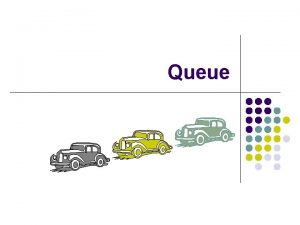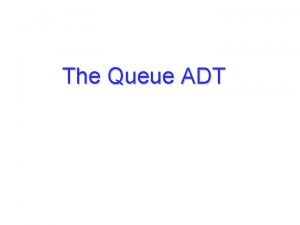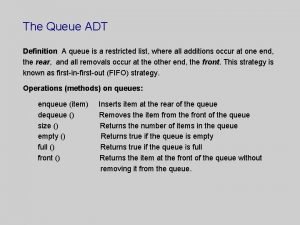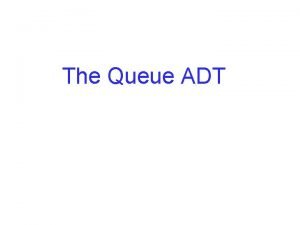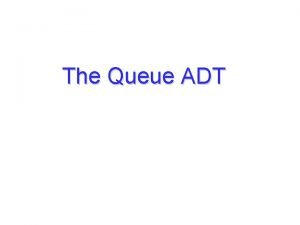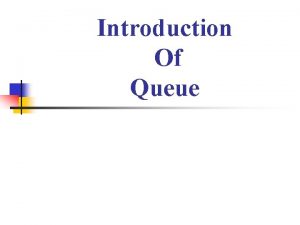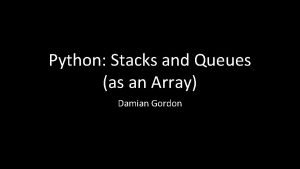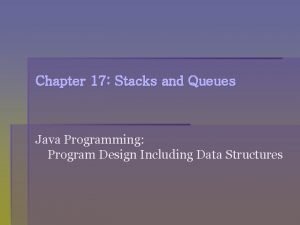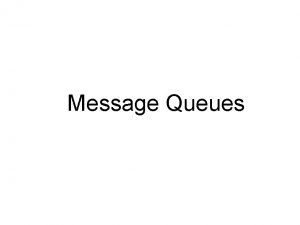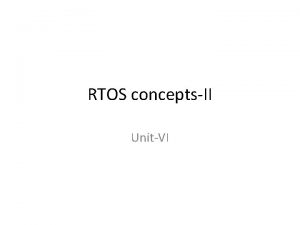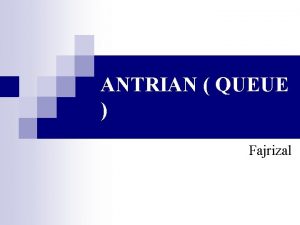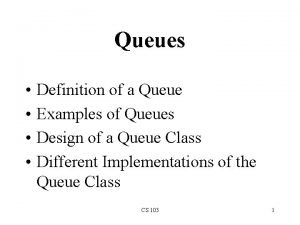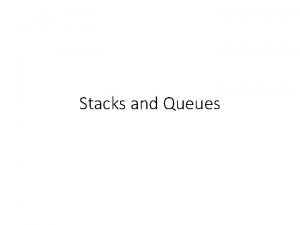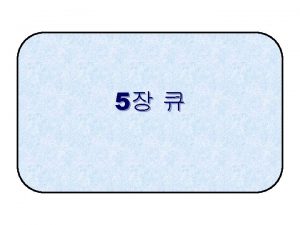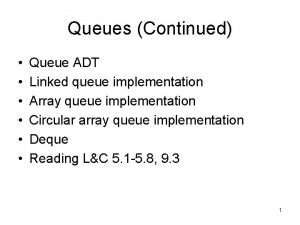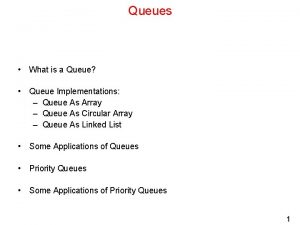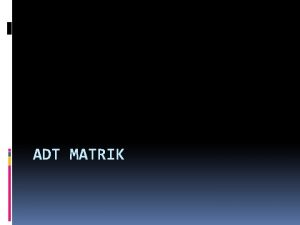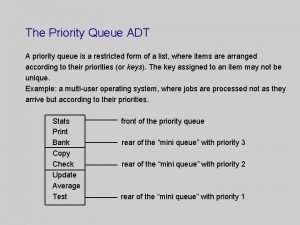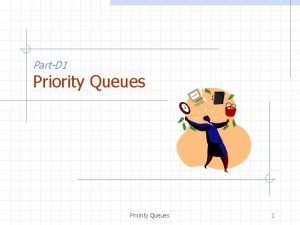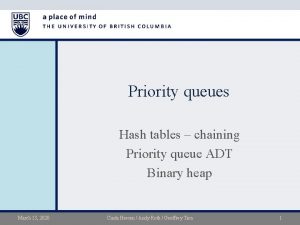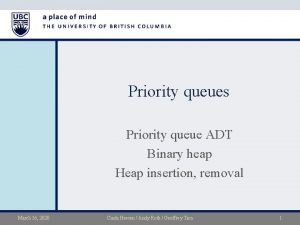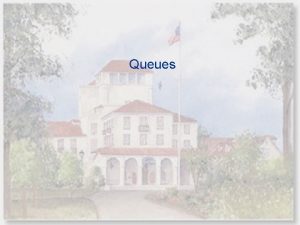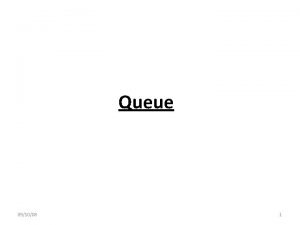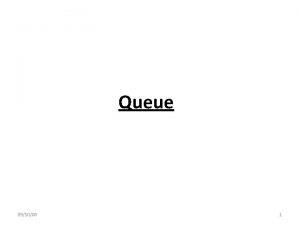Lecture 7 Goals Queues Queue ADT functions for







![class queue { private: point* Q[MSIZE]; int front, rear, size; public: queue() { // class queue { private: point* Q[MSIZE]; int front, rear, size; public: queue() { //](https://slidetodoc.com/presentation_image_h2/666ec5bf94ebd4378f2ce09525897efc/image-8.jpg)















- Slides: 23

Lecture 7 Goals • Queues • Queue ADT • functions for: • Insert • Delete • Breadth-first Search using Queue Sept 19, 2012

Queue Overview • Queue ADT – FIFO (first-in first-out data structure) • Basic operations of queue – Insert, delete etc. • Implementation of queue – Array

Queue ADT • Like a stack, a queue is also a list. However, with a queue, insertion is done at one end, while deletion is performed at the other end. • Accessing the elements of queues follows a First In, First Out (FIFO) order. – Like customers standing in a check-out line in a store, the first customer in is the first customer served.

Insert and delete • Primary queue operations: insert and delete • Like check-out lines in a store, a queue has a front and a rear. • insert - add an element at the rear of the queue • delete – remove an element from the front of the queue Insert Remove front rear

Implementation of Queue • Queues can be implemented as arrays • Just as in the case of a stack, queue operations (insert delete, is. Empty, is. Full, etc. ) can be implemented in constant time

Implementation using Circular Array • When an element moves past the end of a circular array, it wraps around to the beginning, e. g. – OOOOO 7963 (insert(4)) 4 OOOO 7963 • How to detect an empty or full queue, using a circular array? – Use a counter for the number of elements in the queue. – size == ARRAY_SIZE means queue is full – Size == 0 means queue is empty.

Queue Class • Attributes of Queue – front/rear: front/rear index – size: number of elements in the queue – Q: array which stores elements of the queue • Operations of Queue – Is. Empty(): return true if queue is empty, return false otherwise – Is. Full(): return true if queue is full, return false otherwise – Insert(k): add an element to the rear of queue – Delete(): delete the element at the front of queue
![class queue private point QMSIZE int front rear size public queue class queue { private: point* Q[MSIZE]; int front, rear, size; public: queue() { //](https://slidetodoc.com/presentation_image_h2/666ec5bf94ebd4378f2ce09525897efc/image-8.jpg)
class queue { private: point* Q[MSIZE]; int front, rear, size; public: queue() { // initialize an empty queue front = 0; rear = 0; size = 0; for (int j=0; j < MSIZE; ++j) Q[j] = 0; } void insert(point* x) { if (size != MSIZE) { front++; size++; if (front == MSIZE) front = 0; Q[front] = x; } }

point* delete() { if (size != 0) { rear++; if (rear == MSIZE) rear = 0; size--; return Q[rear]; }; } bool is. Empty() { return (size == 0); } bool is. Full() { return (size == MSIZE); } };

Breadth-First Search • “Explore” a graph, turning it into a tree – One vertex at a time – Expand frontier of explored vertices across the breadth of the frontier • Builds a tree over the graph – Pick a source vertex to be the root – Find (“discover”) its children, then their children, etc.

Breadth-First Search • Again will associate vertex “colors” to guide the algorithm – White vertices have not been discovered • All vertices start out white – Grey vertices are discovered but not fully explored • They may be adjacent to white vertices – Black vertices are discovered and fully explored • They are adjacent only to black and gray vertices • Explore vertices by scanning adjacency list of grey vertices

Review: Breadth-First Search BFS(G, s) { initialize vertices; Q = {s}; // Q is a queue; initialize to s color all vertices WHITE; set d[s] = 0 and d[u] = Max. Int for all other u. while (Q not empty) { u = Q->delete(); for each v u->adj { if (v->color == WHITE) v->color = BLACK; What does v->d represent? d[v] = d[u] + 1; What does v->p represent? p[v] = u; Q->insert(v); } } }

Breadth-First Search: Example r s t u v w x y

Breadth-First Search: Example r s t u 0 v w x y Q: s

Breadth-First Search: Example r s t u 1 0 1 v w x y Q: w r

Breadth-First Search: Example r s t u 1 0 2 1 2 v w x y Q: r t x

Breadth-First Search: Example r s t u 1 0 2 2 1 2 v w x y Q: t x v

Breadth-First Search: Example r s t u 1 0 2 3 2 1 2 v w x y Q: x v u

Breadth-First Search: Example r s t u 1 0 2 3 2 1 2 3 v w x y Q: v u y

Breadth-First Search: Example r s t u 1 0 2 3 2 1 2 3 v w x y Q: u y

Breadth-First Search: Example r s t u 1 0 2 3 2 1 2 3 v w x y Q: y

Breadth-First Search: Example r s t u 1 0 2 3 2 1 2 3 v w x y Q: Ø

Breadth-first search to count number of letters BFS: application that can be implemented using a queue. Our application involves finding the number of distinct letters that appear in an image and draw bounding boxes around them. Taken from the output of the BFS algorithm
 Strategic goals tactical goals operational goals
Strategic goals tactical goals operational goals Strategic goals tactical goals operational goals
Strategic goals tactical goals operational goals Queue adt
Queue adt Adt queue
Adt queue Circular array
Circular array Queue adt example
Queue adt example Adaptable priority queue
Adaptable priority queue Queue adt
Queue adt Queue adt
Queue adt Double ended queue
Double ended queue Cqueue
Cqueue Priority queues: quiz
Priority queues: quiz Java stacks and queues
Java stacks and queues Queue representation
Queue representation Exercises on stacks and queues
Exercises on stacks and queues Ipcs unix
Ipcs unix Message queues in rtos
Message queues in rtos Applications of priority queues
Applications of priority queues Jenis jenis queue
Jenis jenis queue Definition of queu
Definition of queu Aganj
Aganj Java stacks and queues
Java stacks and queues 01:640:244 lecture notes - lecture 15: plat, idah, farad
01:640:244 lecture notes - lecture 15: plat, idah, farad General goals and specific goals
General goals and specific goals


